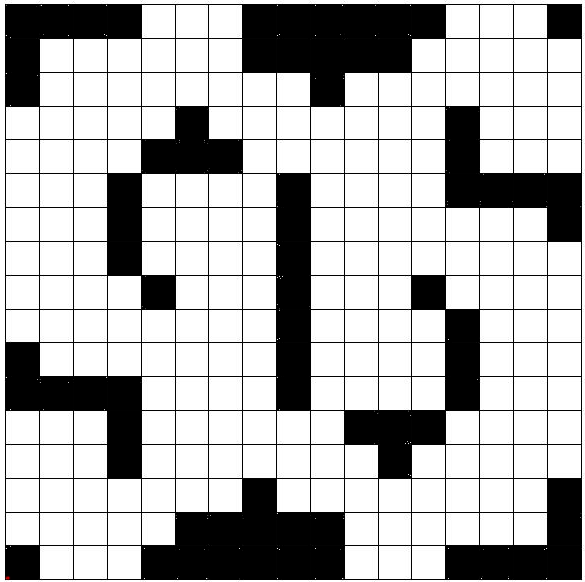I have been completing the New York Times diagramless puzzles now for some time. I have decided that I will share my experience here. I will cover methods of solving in this first post and future posts I will discuss puzzles when I solve them.
What is a Diagramless puzzle?
A diagramless puzzle is a crossword puzzle with the added challenge that the grid is completely blank as shown here.
The New York Times Crosswords run this type of puzzle roughly one time per month on Sundays.
Solving methodology
The Hint
First things first. The hint gives you huge amounts of information (for an added challenge, do the puzzle without that knowledge. It tells you where the first across answer starts, the number of squares (which is obvious from the grid) , and the symmetry.
Symmetry
Crossword symmetry is very crucial hint. This gives you the advantage of knowing what the other part of the puzzle will look like once you have solved other parts.
Regular Crossword Symmetry
If you have ever done a crossword puzzle, or even looked at a grid before, there is an obvious symmetry of the puzzle. This symmetry can be best described as '180-degree rotational (also known as "radial") symmetry' (source) The following diagram shows the symmetry where each colored square corresponds to the same colored square. One way to think of the symmetry is such: If you cut along the blue or green line, and then rotate the piece 180 degrees, the other half will be identical.
Note that this symmetry is traditional to the US.
Color Coded Example
A Filled Example
Other Crossword Symmetry
TBD
The Rules
There are a couple of rules, which are generally followed.
- A clue cannot be less than 3 letters in length which means each letter in the word will be used in two clues (aka "Checked") (Mainly US)
- A blank square which has a solid or edge border on the left will have an across clue, any which has said border on the top will have a down clue.
- The puzzle will not be segmented by black squares
Observations
These are some general trends that I have noticed which may or may not be rules.
- No Answer will be a word within any of the clues.
- No word will repeat in the gird, excepting articles and prepositions. Occasionally this is breached, but usually in cases of theme answers.
- Tense of the answer will match the clue, i.e. plural, past-tense, present tense, &c.
- Generally, the puzzle is square (equal number vertical+ horizontal) and the "dimensions" are odd. e.g. 15x15, 17x17, &c.
- I have yet to see a rebus in a diagramless puzzle, though that would be an interesting increase in difficulty.
- Clues ending with a ? are typically a pun
The Clues
The first thing I do when solving these puzzles is to identify which clue numbers are both in across and down. This helps in identifying which clues will have both a left and top edge.
1-Across
With the knowledge from the above, the first answer space can easily be determined given the following information
- We known from the hint that the answer starts in a certain square.
- We know from using the across clues how long the answer is.
Example:
Hint: This diagramless is 17 squares wide by 17 squares deep and has regular crossword symmetry. 1-Across begins in the seventh square in the first row.
Across clues are 1, then 8. Down clues are 1,2,3,4,5,6,7,8,...
This would result as depicted below. Note that without further information there is ambiguity as to know where 8-Across starts.




The release to your Duo/Duet part is the very first time your viewers is shown the actual individuals behind the characters--an viewers can glance how you and your spouse truly communicate. While including reality and chemical make up, insights for each can also either add strength to a Duo/Duet or constrain the atmosphere. crossword puzzle help
ReplyDeleteNice crossword blog you have here, congratulations on the effort to build it, diagramless puzzles are very interesting. I have a related blog too, you may visit it at:
ReplyDeleteCrossword Puzzle Easy Games Free